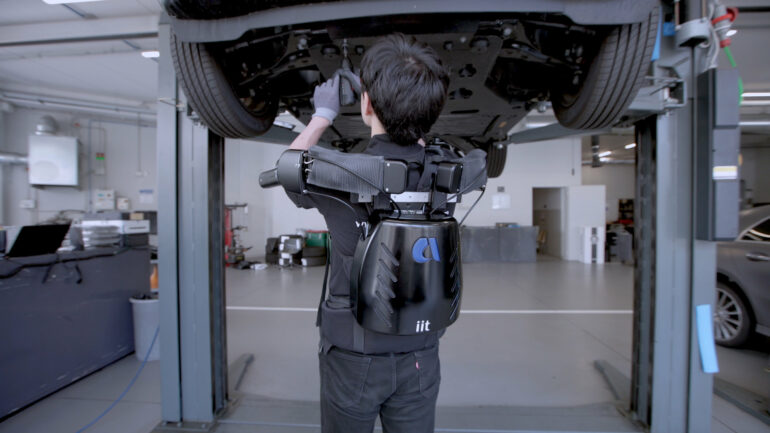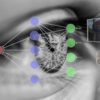Researchers at IIT-Istituto Italiano di Tecnologia (Italian Institute of Technology) and INAIL (Italian Worker’s Compensation Authority) have designed and created innovative prototypes of wearable robotic exoskeletons for industrial use to make work in the industrial and manufacturing sectors safer. Via electric motors and artificial intelligence algorithms, these wearable robotic devices will assist workers engaged in the most physically demanding tasks, significantly reducing the effort required by up to 40% and lowering the percentage of accidents at work and chronic occupational disorders. Researchers are starting to test the prototypes in real scenarios and are planning further development in order to reach the technological level required to bring them to the market in few years.
In Italy, occupational injuries affecting the musculoskeletal system are the most frequent complaints in the workplace: 68% of the occupational injuries reported to INAIL are related to the musculoskeletal system. Of this percentage, the largest share (about 41%) concerns the spinal column.
Researchers at IIT and INAIL are working together to find solutions that may help workers in the near future. The new wearable robotic technologies address the most common areas of concern: the first one, named XoTrunk, provides support for the lower-back; the second one, XoShoulder, targets the shoulders; and the third one, XoElbow, reinforces the elbows. Researchers studied the distribution of forces and overexertion of the body while workers executed specific tasks. Using this information, they designed exoskeletons to respond to those stresses, limiting possible musculoskeletal injury. At the same time, researchers studied the interaction between the human body and the three exoskeletons, acquiring important information that will permit them to improve the prototypes and make them ready for market launch.
The three prototypes are a result of the Collaborative Cybernetic Systems project carried out by IIT’s XoLab research team (Wearable Robots, Exoskeletons and Exosuits Laboratory) led by Jesús Ortiz, with cooperation and support from the INAIL Department of Technological Innovation and Safety of Plants, Products and Anthropogenic Installations led by Carlo De Petris.
XoTrunk was designed to reduce the strain of repetitive load-lifting actions for weights of up to 20 kg, and more generally it is dedicated to all those jobs that could fatigue the operator’s back. In addition, it is the only device of its kind that can also provide support for pulling operations, which are very common in the logistics sector. The exoskeleton, weighing 6.5 kg, is fitted with two electric motors with a total power of 200 Watts and a torque of 30 N/m each. XoTrunk can also be used in synergy with XoKnee, a soft exoskeleton that connects to the robot and offers the operator even greater support during repetitive load-lifting tasks.
XoShoulder was developed to meet the needs of people who exert their shoulders in the course of their daily work. The typical scenario is that of a mechanical workshop scenario where the operators are working under vehicles placed on car lifts and are subjected to shoulder fatigue because they have to hold heavy tools above shoulder level for prolonged periods of time. The prototype, which weighs about 7.7 kg and is equipped with two 70-watt motors with a torque of 12 N/m each, currently represents a unique design from a mechatronic and control point of view.
XoElbow is a prototype that helps lifting weights close to the operator’s body. An example of its application would be lifting heavy tires to fit them on a car on an automotive lift. It is equipped with the same motors as XoShoulder and weighs about 7 kg. Similarly to XoShoulder, this device presents unique characteristics in the field of exoskeletons.
All three wearable robots are made of engineering plastics and aluminum alloys usually employed for aerospace applications, and they are designed for the principal industrial contexts in which operators, both male and female, are likely to put excessive stress onto their musculoskeletal systems: manufacturing, maintenance, food processing, logistics, construction, and agriculture.
These prototypes use artificial intelligence algorithms to provide the appropriate assistance according to the type of work and the way in which it is performed. Another feature common to all these devices and fundamental for this type of equipment is transparency. In fact, the robots should not hinder or limit mobility, but come into operation only for the most demanding tasks, providing support for the workers’ musculoskeletal system.
At present, XoTrunk is undergoing initial testing at selected companies for field trials and, by means of an IIT start-up project (Proteso) that has been launched this year, it is expected to be placed in the market over the next months. XoElbow and XoShoulder will start their real-life scenario testing over the next few months, and it is expected that they could be available in the market in the next few years.
Provided by
Italian Institute of Technology
Citation:
New prototype exoskeletons for industrial workers (2022, June 15)



